2016 Peugeot 308 deactivate passenger airbag
[x] Cancel search: deactivate passenger airbagPage 18 of 398

16
Warning / indicator lampStateCause Action / Observations
Automatic
wiping fixed.
the w
iper control is pushed
downwards. Automatic front wiping is activated.
to de
activate automatic wiping, operate the control
stalk downwards or put the stalk into another position.
Passenger
airbag system fixed.
the control switch, located at the
p assenger's end of the dashboard, is in
the "ON " position.
the p
assenger's front airbag is activated.
In this case, do not install a rear ward
facing child seat on the front passenger
seat.turn the control switch to the " O FF" position to
deactivate the passenger's front airbag.
You can install a rear ward facing child seat, unless
there is a fault with the airbags (airbag warning
lamp
o
n).
Stop & Star t fixed. When the vehicle stops (red lights,
traffic jams,
.
..) the Stop & Start system
has put the engine into S
tOP m
ode.
the w
arning lamp goes off and the engine restarts
automatically in S
tARt m
ode, as soon as you want to
move off.
flashes for a few
seconds, then goes
of f. S
tOP m
ode is temporarily
unavailable.
or
S
tARt m
ode is invoked
automatically. For more information on Stop & Start, refer to the
corresponding section.
Blind spot sensors
(depending on
ve r s i o n)fixed.the b
lind spot monitoring function
has been activated. For more information on the blind spot sensor system,
refer to the corresponding section.
Instruments
Page 19 of 398
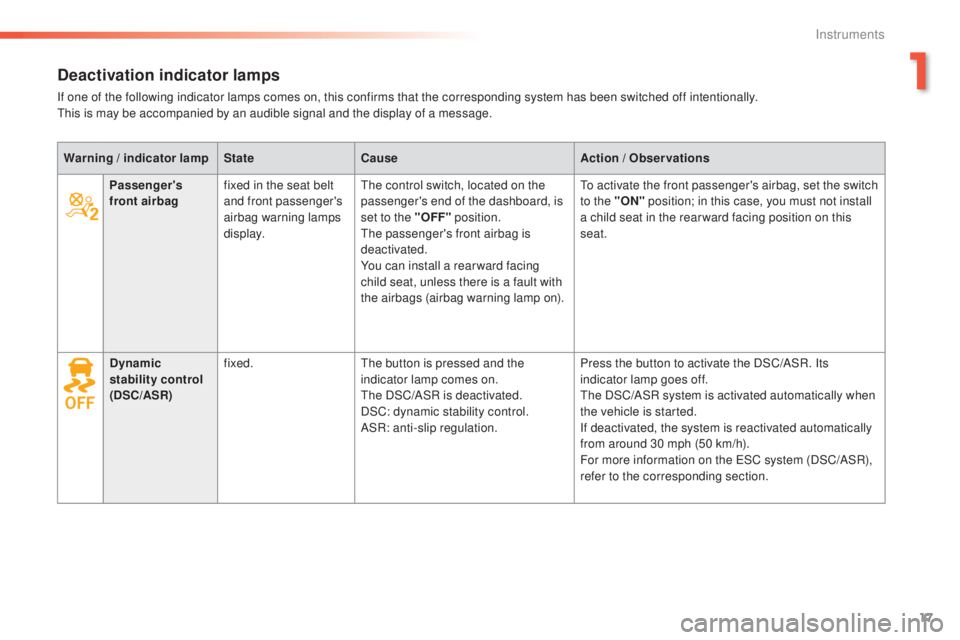
17
308_en_Chap01_instruments-de-bord_ed02-2015
Deactivation indicator lamps
If one of the following indicator lamps comes on, this confirms that the corresponding system has been switched off intentionally.this is may be accompanied by an audible signal and the display of a message.
Warning
/
indicator lamp State Cause Action
/
Observations
Passenger's
front airbag fixed in the seat belt
and front passenger's
airbag warning lamps
display.
the c
ontrol switch, located on the
passenger's end of the dashboard, is
set to the "OFF" position.
the p
assenger's front airbag is
deactivated.
You can install a rear ward facing
child seat, unless there is a fault with
the airbags (airbag warning lamp on).
to ac
tivate the front passenger's airbag, set the switch
to the "ON" position; in this case, you must not install
a child seat in the rear ward facing position on this
seat.
Dynamic
stability control
(DSC/ASR) fixed.
the b
utton is pressed and the
indicator lamp comes on.
the DS
C/ASR is deactivated.
DSC: dynamic stability control.
ASR: anti-slip regulation. Press the button to activate the DSC/ASR. Its
indicator lamp goes off.
the D
SC/ASR system is activated automatically when
the vehicle is started.
If deactivated, the system is reactivated automatically
from around 30 mph (50 km/h).
For more information on the
eS
C system (DSC/ASR),
refer to the corresponding section.
1
Instruments
Page 128 of 398
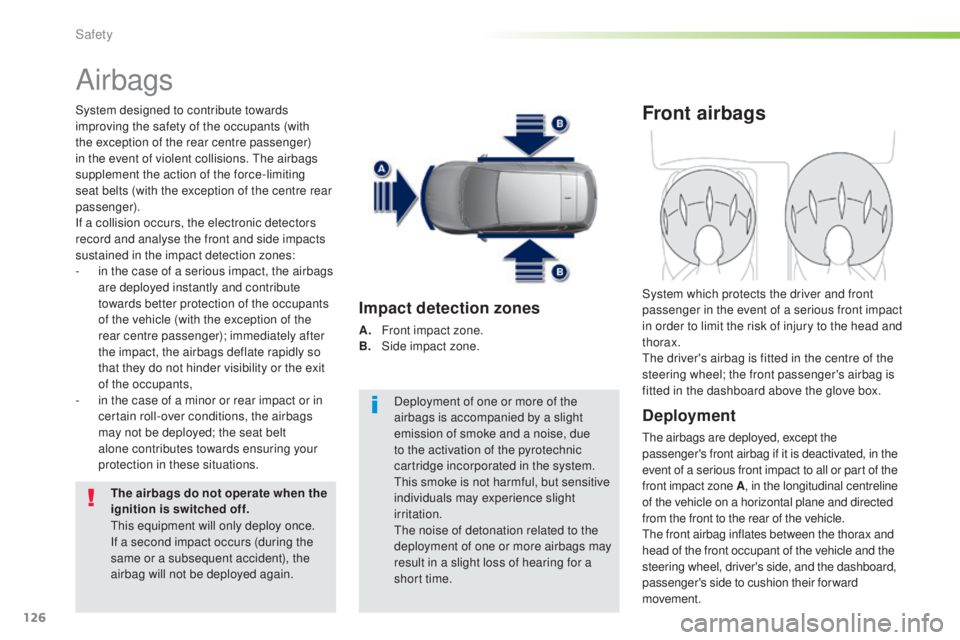
126
308_en_Chap05_securite_ed02-2015
Airbags
System designed to contribute towards
improving the safety of the occupants (with
the exception of the rear centre passenger)
in the event of violent collisions.
the a
irbags
supplement the action of the force-limiting
seat belts (with the exception of the centre rear
passenger).
If a collision occurs, the electronic detectors
record and analyse the front and side impacts
sustained in the impact detection zones:
-
in t
he case of a serious impact, the airbags
are deployed instantly and contribute
towards better protection of the occupants
of the vehicle (with the exception of the
rear centre passenger); immediately after
the impact, the airbags deflate rapidly so
that they do not hinder visibility or the exit
of the occupants,
-
in t
he case of a minor or rear impact or in
certain roll-over conditions, the airbags
may not be deployed; the seat belt
alone contributes towards ensuring your
protection in these situations.
The airbags do not operate when the
ignition is switched off.
thi
s equipment will only deploy once.
If a second impact occurs (during the
same or a subsequent accident), the
airbag will not be deployed again. Deployment of one or more of the
airbags is accompanied by a slight
emission of smoke and a noise, due
to the activation of the pyrotechnic
cartridge incorporated in the system.
thi
s smoke is not harmful, but sensitive
individuals may experience slight
irritation.
the n
oise of detonation related to the
deployment of one or more airbags may
result in a slight loss of hearing for a
short time.
Impact detection zones
A. Front impact zone.
B. Si de impact zone.
Front airbags
Deployment
the airbags are deployed, except the
p assenger's front airbag if it is deactivated, in the
event of a serious front impact to all or part of the
front impact zone A , in the longitudinal centreline
of the vehicle on a horizontal plane and directed
from the front to the rear of the vehicle.
the f
ront airbag inflates between the thorax and
head of the front occupant of the vehicle and the
steering wheel, driver's side, and the dashboard,
passenger's side to cushion their forward
movement. System which protects the driver and front
passenger in the event of a serious front impact
in order to limit the risk of injury to the head and
thorax.
the d
river's airbag is fitted in the centre of the
steering wheel; the front passenger's airbag is
fitted in the dashboard above the glove box.
Safety
Page 129 of 398
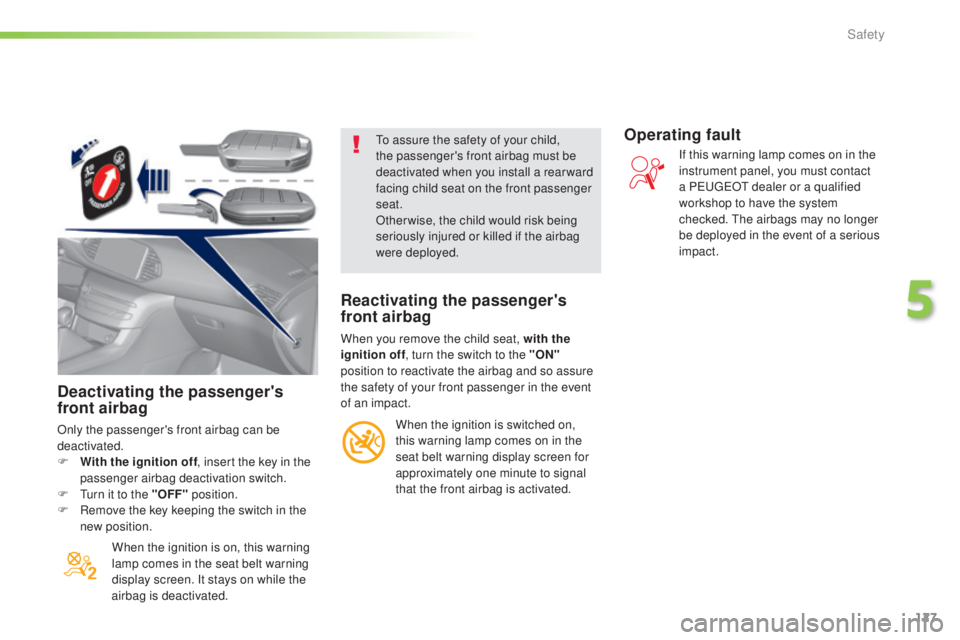
127
308_en_Chap05_securite_ed02-2015
Deactivating the passenger's
front airbag
Only the passenger's front airbag can be
deactivated.
F
Wi
th the ignition off , insert the key in the
passenger airbag deactivation switch.
F
t
ur
n it to the "OFF" position.
F
Re
move the key keeping the switch in the
new position.
When the ignition is on, this warning
lamp comes in the seat belt warning
display screen. It stays on while the
airbag is deactivated.
to as
sure the safety of your child,
the passenger's front airbag must be
deactivated when you install a rear ward
facing child seat on the front passenger
seat.
Otherwise, the child would risk being
seriously injured or killed if the airbag
were deployed.
Reactivating the passenger's
front airbag
When you remove the child seat, with the
ignition off , turn the switch to the "ON"
position to reactivate the airbag and so assure
the safety of your front passenger in the event
of an impact.
When the ignition is switched on,
this warning lamp comes on in the
seat belt warning display screen for
approximately one minute to signal
that the front airbag is activated.
Operating fault
If this warning lamp comes on in the
instrument panel, you must contact
a P
eu
ge
Ot d
ealer or a qualified
workshop to have the system
checked.
the a
irbags may no longer
be deployed in the event of a serious
impact.
5
Safety
Page 134 of 398
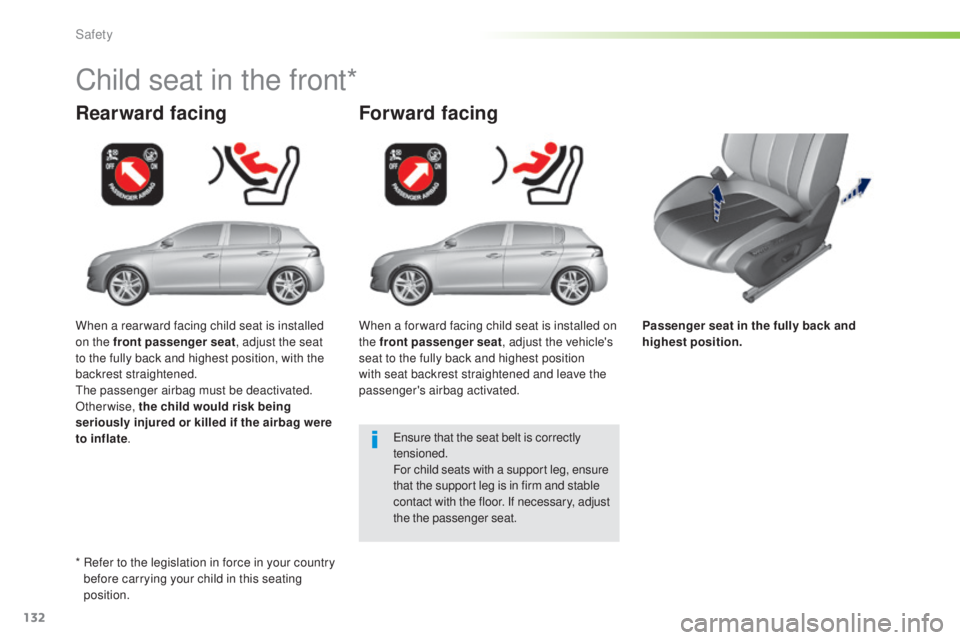
132
308_en_Chap05_securite_ed02-2015
Passenger seat in the fully back and
highest position.
Rearward facing
Child seat in the front*
Forward facing
ensure that the seat belt is correctly
t ensioned.
For child seats with a support leg, ensure
that the support leg is in firm and stable
contact with the floor. If necessary, adjust
the the passenger seat.
When a rear ward facing child seat is installed
on the front passenger seat
, adjust the seat
to the fully back and highest position, with the
backrest straightened.
the p
assenger airbag must be deactivated.
Otherwise, the child would risk being
seriously injured or killed if the airbag were
to inflate . When a for ward facing child seat is installed on
the front passenger seat
, adjust the vehicle's
seat to the fully back and highest position
with seat backrest straightened and leave the
passenger's airbag activated.
*
Re
fer to the legislation in force in your country
before carrying your child in this seating
position.
Safety
Page 140 of 398
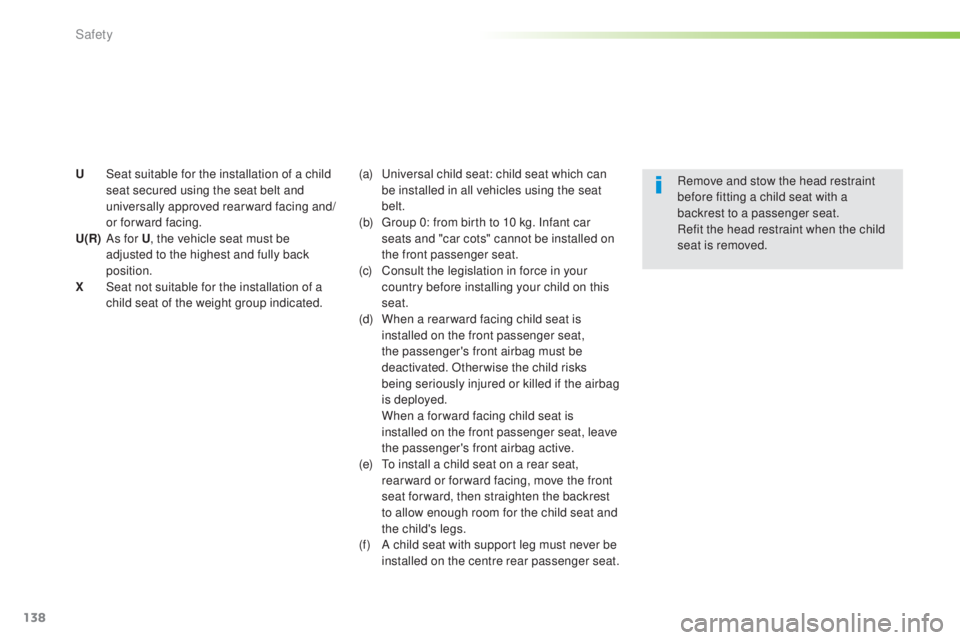
138
308_en_Chap05_securite_ed02-2015
U Seat suitable for the installation of a child
seat secured using the seat belt and
universally approved rearward facing and/
or forward facing.
U(R)
As f
or U, the vehicle seat must be
adjusted to the highest and fully back
position.
X
Se
at not suitable for the installation of a
child seat of the weight group indicated. Remove and stow the head restraint
before fitting a child seat with a
backrest to a passenger seat.
Refit the head restraint when the child
seat is removed.
(a)
uni versal child seat: child seat which can
be installed in all vehicles using the seat
belt.
(b)
g
ro
up 0: from birth to 10 kg. Infant car
seats and "car cots" cannot be installed on
the front passenger seat.
(c)
Co
nsult the legislation in force in your
country before installing your child on this
seat.
(d)
Wh
en a rear ward facing child seat is
installed on the front passenger seat,
the passenger's front airbag must be
deactivated. Otherwise the child risks
being seriously injured or killed if the airbag
is deployed.
Wh
en a for ward facing child seat is
installed on the front passenger seat, leave
the passenger's front airbag active.
(e)
t
o in
stall a child seat on a rear seat,
rear ward or for ward facing, move the front
seat for ward, then straighten the backrest
to allow enough room for the child seat and
the child's legs.
(f)
A ch
ild seat with support leg must never be
installed on the centre rear passenger seat.
Safety
Page 146 of 398
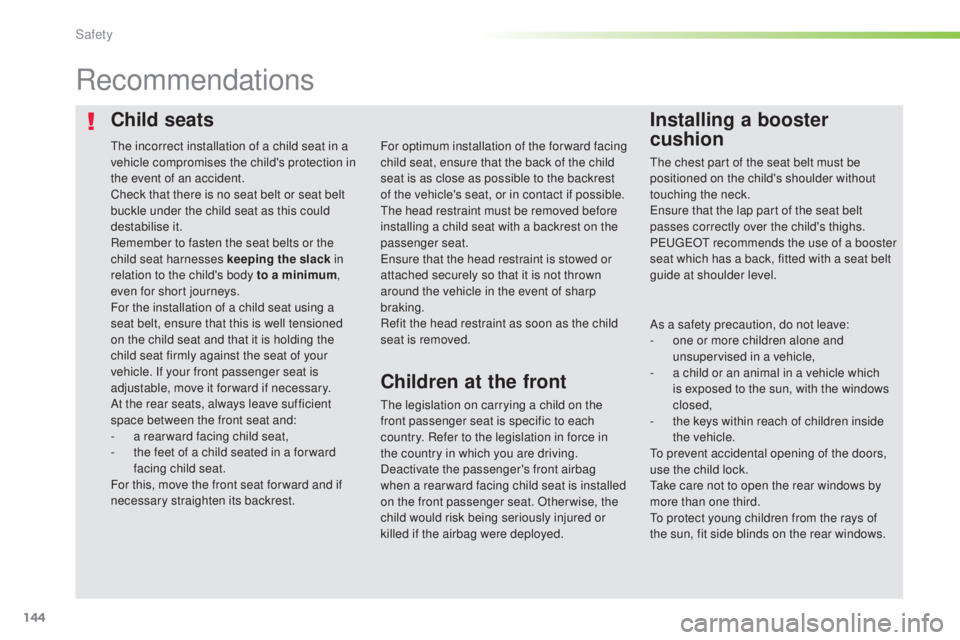
144
308_en_Chap05_securite_ed02-2015
Child seatsInstalling a booster
cushion
Recommendations
the legislation on carrying a child on the
f ront passenger seat is specific to each
country. Refer to the legislation in force in
the country in which you are driving.
Deactivate the passenger's front airbag
when a rear ward facing child seat is installed
on the front passenger seat. Otherwise, the
child would risk being seriously injured or
killed if the airbag were deployed. For optimum installation of the forward facing
child seat, ensure that the back of the child
seat is as close as possible to the backrest
of the vehicle's seat, or in contact if possible.
the h
ead restraint must be removed before
installing a child seat with a backrest on the
passenger seat.
ens
ure that the head restraint is stowed or
attached securely so that it is not thrown
around the vehicle in the event of sharp
braking.
Refit the head restraint as soon as the child
seat is removed.
the i
ncorrect installation of a child seat in a
vehicle compromises the child's protection in
the event of an accident.
Check that there is no seat belt or seat belt
buckle under the child seat as this could
destabilise it.
Remember to fasten the seat belts or the
child seat harnesses keeping the slack in
relation to the child's body to a minimum ,
even for short journeys.
For the installation of a child seat using a
seat belt, ensure that this is well tensioned
on the child seat and that it is holding the
child seat firmly against the seat of your
vehicle. If your front passenger seat is
adjustable, move it forward if necessary.
At the rear seats, always leave sufficient
space between the front seat and:
-
a re
ar ward facing child seat,
-
th
e feet of a child seated in a for ward
facing child seat.
For this, move the front seat for ward and if
necessary straighten its backrest.
Children at the front
the chest part of the seat belt must be
p ositioned on the child's shoulder without
touching the neck.
ens
ure that the lap part of the seat belt
passes correctly over the child's thighs.
P
eu
ge
Ot r
ecommends the use of a booster
seat which has a back, fitted with a seat belt
guide at shoulder level.
As a safety precaution, do not leave:
-
on
e or more children alone and
unsupervised in a vehicle,
-
a ch
ild or an animal in a vehicle which
is exposed to the sun, with the windows
closed,
-
th
e keys within reach of children inside
the vehicle.
to pr
event accidental opening of the doors,
use the child lock.
tak
e care not to open the rear windows by
more than one third.
to pr
otect young children from the rays of
the sun, fit side blinds on the rear windows.
Safety